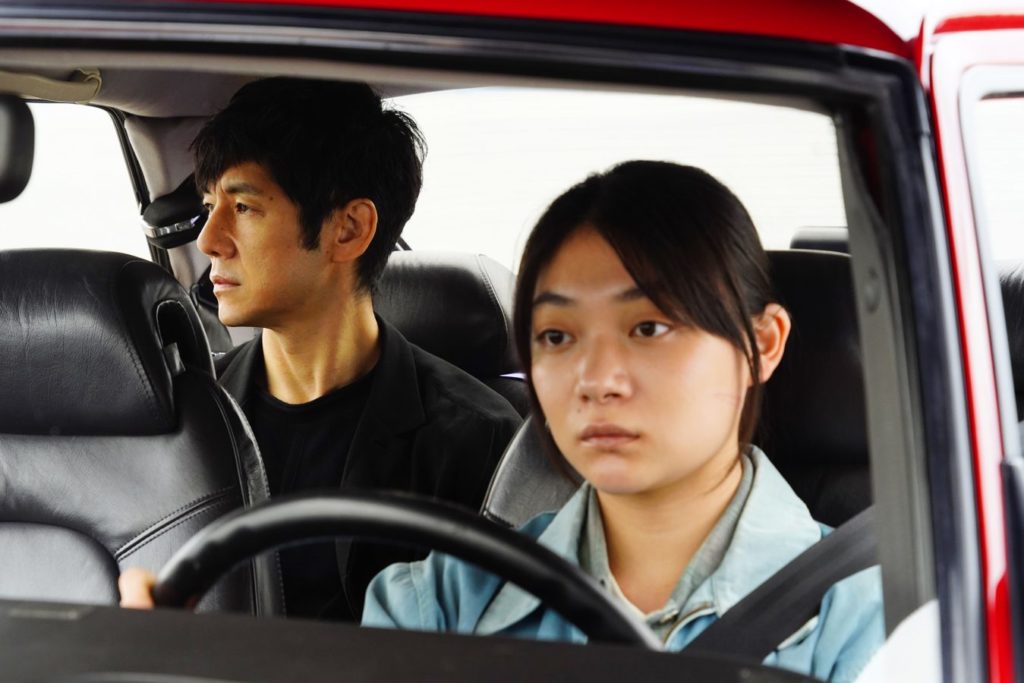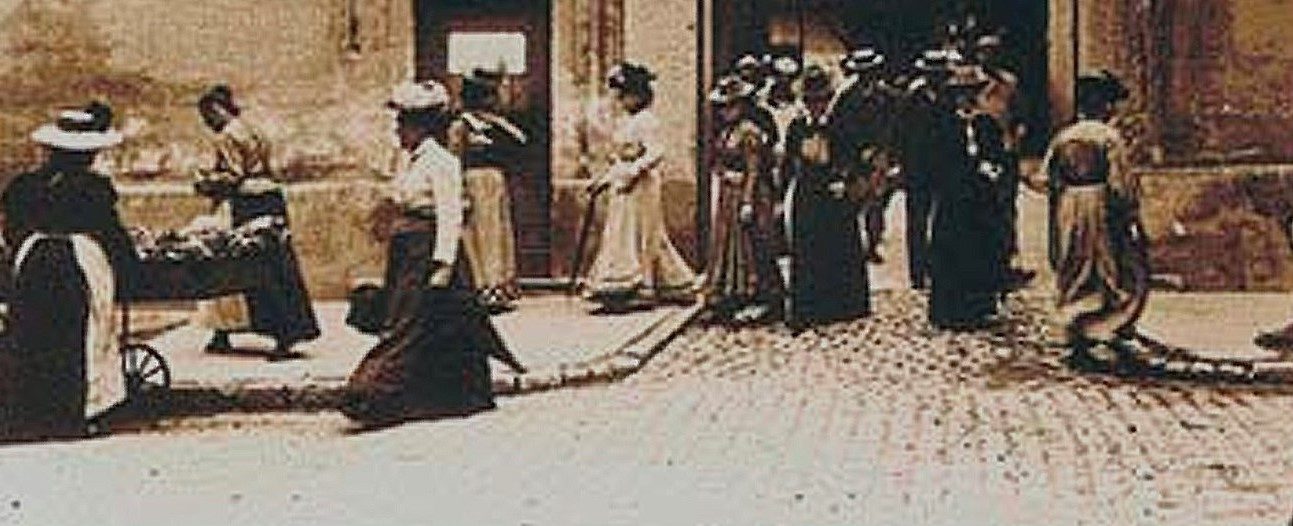Japan, 2021
Directed by Hamaguchi Ryûsuke
With Nishijima Hidetoshi (Kafuku Yûsuke), Kirishima Reika (Kafuku Oto), Miura Tôko (Watari Misaki), Okada Misaki (Takatsuki Koshi), Park Yurim (Lee Yoon-e), Jin Daeyeon (Yoon-su), Sonia Yuan (Janice Chan)

The titles are displayed in a remarkably unusual way: only a few roll on the screen as the film is off with a visually arresting, fascinating start; then the narrative unfolds till a climax of sorts takes place; and lo and behold here come the titles rolling in full, with most of the film’s credits – this brings to mind the trick used by director Jia Zhangke in his 2015 feature “Shan he gu ren – Mountains May Depart”, but it was then the opposite, with details first, and later the film’s title and the directorial credit.
On the face of it, the trick has the same function, to separate in a visually original but clear way two parts of the same story. As the film proceeds, the contents must be characterized in more precise terms: what came before the full titles seem like a prologue to what follows, and is the real story. The prologue introduces the characters and leads to a climax whose reverberations are what is truly at stake. The first shot, in retrospect, is even more telling than it sounds, heralding subtly the lead character’s tragedy: a naked woman sitting on a bed spin a weird yarn of perversion; she is shot in medium shot against the light, looking like an intriguing and spell-casting silhouette. As it happens, Kafuku Oto would haunt her husband Kafuku Yûsuke, who loses her twice in the prologue, first to a lover, and then to death, and would not get over her disappearance that easily – the film’s story, in the long, fluid, complex series of sequences after the titles is a heartbreaking tale of grief and survival, his meandering path to the needed sense of closure, belated acceptance of what has gone, and what has not been achieved, the tentative, painful, resigned embrace of life as it goes on.
Sound and voice matter a lot. As Kafuku Yûsuke explains to his driver, and guide to resignation, Watari Misaki, the first name of his late wife implies in Japanese the idea of sound, even it seems of music note. Oto is the sound of creation: a former actress, she has become a screenwriter and oddly gets part of her inspiration through carnal knowledge, especially by making love with her hubby. She also highly appreciates to discuss her ideas with Yûsuke, an actor and stage director, and a real creative partner to her, hence the scenes where they talk about her ideas while in Yûsuke’s car. But she also helps him a lot, by recording texts he works on for theater shows, leaving a blank in the tape whenever his character needs to speak – he likes to drive while playing these tapes, rehearsing and preparing his work while driving around the city. Of course, after Oto’s death, listening to the tapes gets an unspoken but vivid layer of emotion, and when he claims he cannot work differently, and so cannot easily accept to have a driver, and not drive himself, there is another feeling at play. The memory of Oto still possesses him, two years after her death (an intertitle has explained that what comes after the titles takes place “two years later”).
Differences in voices matter, by the way, in Yûsuke’s work as a stage director: he gains fame and respect by his avant-garde take on live performances. High above the stage, a screen displays the lines uttered by the cast in various languages, including Japanese, the native language of many of the actors and all of the audience, English, the modern lingua franca, and others – for the simple reason that indeed not all the actors he works with are Japanese, Yûsuke seeking to create a multi-ethnic and cosmopolitan performance. In the prologue, his approach is first used, though on a small-scale, to stage the groundbreaking 1952 play of Samuel Beckett, “Waiting for Godot”; at the end, his method is applied to performances of the 1899 play by Anton Chekhov, “Uncle Vanya”, with Russian actors and Yûsuke himself in the titular role. Trouble is, he struggles to perform, the play’s contents clearly overwhelming him as he is still mourning Oto.
Two years later, he is invited to a theater festival in Hiroshima. With the help of one of the top managers of the festival, South Korean Lee Yoon-e, Yûsuke mounts a new performance of his “Uncle Vanya”, willfully choosing a cast from various backgrounds, from Indonesia to China, and including a mute (but not deaf) young woman, Yoon-su, who is going to play with the sign language. It also involves a bright young Japanese actor from the television, Takatsuki Koshi, who, as Yûsuke learned tragically, had an affair with Oto (and is still fascinated by her). The film, on one level, is the chronicle of how such a bold endeavor is first organized and then managed till the natural conclusion, a performance before an audience. The demands of Yûsuke are not easy, it should be said, to understand for the cast; but the real trouble comes from Koshi, who does not gather why he has the biggest role in the play, who is flirting with another actress, Janice Chang, who tries to get Yûsuke talk about Oto, still grappling with his own grief and seeking revelations and confessions, and who, more embarrassingly, tends to pick up a fight with whoever dares to take a picture of him (he is still smarting from the scandal his affair with a young actress caused).
On the other level, the film relates the awkward encounter between Yûsuke, who does not like to lend his car to others (a brief scene in the prologue made the point, as he slammed Oto for her driving habits), is adamant he can drive without a hitch (even though he knows it cannot last, as he has been diagnosed in the prologue with glaucoma), and does not want to give up his habit of listening his precious tapes while holding the steering wheel, and the driver the festival, out of bureaucratic reasons, compels him to have, the young woman named Watari Misaki. Misaki is a gifted driver, far more than the thespian thought, but she is not talkative and looks always sullen and distant, though she is remarkably polite. Yûsuke does not know quite how to connect with her even as he is more and more sympathetic to her.
In a slow and steady way these two narrative strands get entwined, and things get even more complex, thanks in part to the car and the play. The car becomes the scene of a cathartic conversation between the men who loved Oto and later the only space available to find a solution to the crisis sparked by the police arrest of Koshi. The play, or rather the way it is read and played, gets Yûsuke and Misaki closer, but also proves an increasingly magical and moving experience for the cast and the driver. The play reveals itself too as a mirror to the drama of real life, as Yûsuke like Uncle Vanya is challenged but then tries to find peace, with the help of a young woman he likes so much. The smooth way the screenplay builds twists, turns, developments, and reactions is amazingly bold and subtle, knocking down the walls between different realities, as well as those Yûsuke has build against his grief. The bond he forges with Misaki proves to be his best opportunity to face his guilt of not having talked with Oto as he should have, of not having found the manner to stay true to her, of not coming to terms with what she has deprived him of, and has given to him, too. Discovering another pain and another guilt releases his angst – as much as his sympathy opens to Misaki doors she has been too easily used to watch closed to her.
The plot of Chekhov’s play is famously simple, dealing about the growing gap between the titular character and his former brother-in-law, Serebrayakov, who is now married to another young woman, Yelena, about what to do with the property inherited by Sonia, Vanya’s niece and the child of Serebriakov’s first marriage. Things get out of hand, a gun is fired, but then life comes back to normal, and Serebrayakov is again viewed with awe, and readily helped with money, even if events have demonstrated how bad he is. The play matters for the mood, the atmosphere, the emotion those events create, and for the overarching theme of resignation, the brave though sad acceptance of the unavoidable though painful. When Yûsuke playing at long last again the part of Uncle Vanya and Yoon-su playing the role of Sonia perform the last scene of the play, it becomes the most moving and riveting moment that can be fathomed: the words of art giving the meaning of the narrative the lead character has lived through. And in its own ways, the film’s dynamics reflects the play – it has conveyed a precious set of moods, atmospherics, emotions driving the audience at the heart of a man and his pain but also giving hope, in the shape not of the sweet hereafter envisioned by Sonia, but of a sullen, distant, and not very talkative girl who becomes far more spirited, warm, and bright.
As the prologue suggested, the film impresses by the way it nicely signals the shape of the things to come, the way it creates a coherent, powerful, solid visual language quietly carrying the audience from the start to the end of this long journey into pain and love. Yûsuke’s willingness to work with many languages points to what the film experience illustrates: the strength and impact of an aesthetic emotion can be easily felt no matter what the tools are as long as they are sincere, deeply felt, intensely played – and even more when it deals clearly, immediately, genuinely with one’s experience in life. “Doraibu mai kâ – Drive My Car” is wonderfully shot and edited, and makes a clever use of a theater play as it has been rarely the case in films – (it brings to mind the last film by Louis Malle, in 1994, “Vanya, 42nd Street”, which displayed the same pleasure and emotion at the way Chekhov’s text taps into the actors’ experiences and feelings). It also offers one of the greatest roles a car can have in a film. Yûsuke’s red SAAB 900 turbo enables the characters to exist, to meet, to talk, to be saved, and thus drive us into a deeply sensitive, perceptive, and delicate examination of the human feelings.

